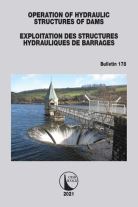Archives
- CDA Annual Conference, 4-5 October 2014, Banff (Alberta-Canada)
- ICID and ICOLD Presidents write to World Bank President
- Tehri dam held raging Ganga and saved lives, July 23rd
- R.I.P. Nelson Mandela (07/12/2013)
- Construction of Belo Monte resumes, 1st Sept 2012
- Infrastructure for green energy, 30 May 2012
- ICOLD President met IHA President, May 2011
- China-Africa : successful workshop and tour, November 2010
- After the floods, from Red Cross to heads of state, a general call for more dams, November 12th
- ICOLD's new homepage
- ICOLD 27th Congress - 90th Annual Meeting - Marseille (France) - 27May to 3June 2022
- 2022 ANCOLD NZSOLD Conference in Sydney, 26-28 October 2022
- ASIA 2023 Water Resources and Renewable Development in Asia 14-16 March 2023
- 2nd International Conference on Dam Safety Management & Engineering (ICDSME2023) - 16-17 March 2023
- HYDROPOWER EUROPE Final Event: “The Important Role of Hydropower in Energy Transition”
- IAHR Webinar on Sustainable Water Engineering Bringing Together the Global Community - 21 March 2023
- Webinar : A FUTURE IN TAILINGS ENGINEERING : An Introduction to a Diverse Career with Immense Opportunities - 27-28 March 2023
- ICOLD-CIGB 2023 - 91st ICOLD Annual Meeting, 11 - 15 June 2023
- Hydrovision International 2023 - Charlotte, NC, USA - 11 to 13 july 2023
- Africa 2023 - 10 - 12 July 2023
- 12th ICOLD European Club Symposium - 5 to 8 September 2023
- XX TECHNICAL DAM CONTROL INTERNATIONAL CONFERENCE - 12 - 15 September 2023
Publications

World Register of Dams / Registre Mondial des Barrages
Buy an access to the online World Register of Dams for 3years.
The WRD is the best available data basis on dams in the world and we are constantly striving to better it.
Events
.jpg)
ANCOLD Conference 2024: Never the same dam twice
Adelaide, Australia
11 - 14 November 2024

HYDRO 2024 Secure technology for turbulent times
Messe Congress Graz (MCG), Austria
18 to 20 November 2024

17th ICOLD International Benchmark Workshop on Numerical Analysis of Dams
Sofia, Bulgaria
9th - 12th April 2025


XXI technical dam control international conference
Cracow, Poland
09 - 12 September 2025
Tehri dam held raging Ganga and saved lives, July 23rd

India: Tehri dam held raging Ganga and saved lives
Heavy floods affected Uttarakhand in India, at the border with Tibet and Nepal, during last month of June. The water inflow from Bhagirathi and its tributaries reached about 7,000 cubic meters per second. If that flow had gone uninterrupted, it would have caused extreme consequences. In the city of Rishikesh, the Ganga would have been flowing 5 meters above the danger level.
But that water inflow was stopped, thanks to the Tehri dam, which stored most of the supplementary water. As a result, the water inflow was reduced to a mere 500 cubic meters per second and the cities downstream (Rishikesh and Haridwar) were protected. An official from Tehri Dam authority explained that, while most power projects in Uttarakhand had stopped generation due to heavy silt depositing in the turbines, the Tehri and Koteshwar dams continued to generate power (respectively 1000 and 400 MW) as usual because they are reservoir storage projects.
A report quoted in the Times of India said the fury of nature in Uttarakhand was such that waters rose as high as a four-storeyed building at Devprayag, where the Alaknanda and Bhagirathi meet, in a 24-hour period after the June 16-17 cloudburst. This rise was unprecedented and could have resulted in total destruction of Rishikesh town and much of Haridwar if the flow of Bhagirathi was not contained by the Tehri reservoir, according to officials of the Tehri Hydro Development Corporation (THD). Rishikesh is famous for its ashrams, which would have been all wiped out.
In Germany, similarly in June, a recently upgraded Sylvenstein dam has protected the city of Munich. An officiel from the Land of Bavaria, Tobias Lang, commented : "The benefit of this reservoir has been enormous. the investment in upgrading measures have more than paid off during major flood events of 1999, 2005 and 2013. It's not easy to find a structure designed to provide protection against natural disasters which has provided such a quick return on investment."
Tags : Events











